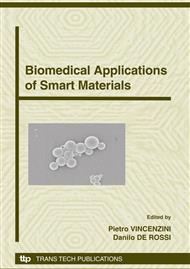p.1
p.5
p.15
p.22
p.31
p.37
p.44
Bioinspired Polymer Surfaces for Nanodevices and Nanomedicine
Abstract:
The phospholipid molecule is one of the typical components of the cell membrane. In particular, the phosphorylcholine polar group is an electrically neutral head group. Arrangement of phospholipid polar groups and construct the surface, we applied 2-methacryloyloxyethyl phosphorylcholine (MPC) polymers bearing a phosphorylcholine group in side chain, which was designed with the cell membrane as an inspiration. Versatile polymers comprising MPC could be synthesized, and their specific biofunctions were evaluated. Establishing an ultimate interface between biological circumstances and artificial materials, so-called biointerfaces, with multiple functions is important from the viewpoint of biomaterials science. Nonspecific protein adsorption is essential for achieving versatile biomedical applications. Simultaneously, bioconjugation and retention of its biofunction are crucial for a high-performance interface. In this article, we would like to introduce effectiveness of interface with highly biological functions composed of the MPC polymers for constructing nanobiodevices and nanomedicine.
Info:
Periodical:
Pages:
5-14
Citation:
Online since:
September 2008
Authors:
Price:
Сopyright:
© 2008 Trans Tech Publications Ltd. All Rights Reserved
Share:
Citation:


